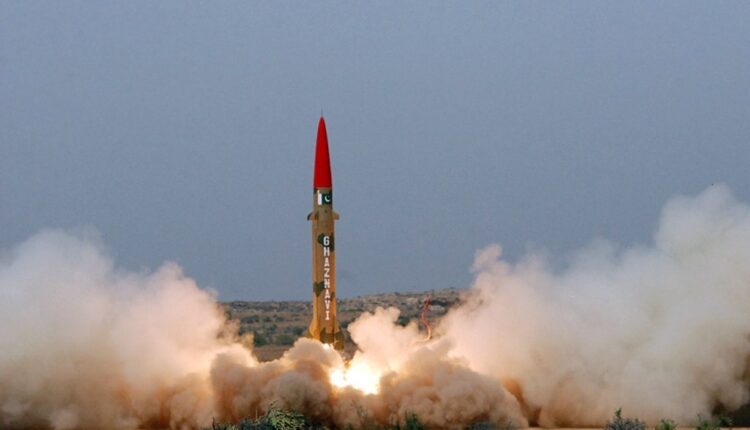(VIDEO) On the Brink of War: Pakistan Launches 450km-Range Abdali Missile in Defiant Show of Force
The launch comes at a time when Islamabad and New Delhi are locked in a cycle of intensifying military brinkmanship following the Pahalgam massacre, with Pakistan’s missile test viewed as a calibrated escalation in response to India's aggressive posture.

(DEFENCE SECURITY ASIA) – Amid dangerously escalating hostilities between South Asia’s two nuclear-armed rivals, Pakistan has conducted a high-profile test launch of its short-range ballistic missile (SRBM), the Abdali (Hatf-II), demonstrating its battlefield strike capability with a range of up to 450 kilometers.
The launch comes at a time when Islamabad and New Delhi are locked in a cycle of intensifying military brinkmanship following the Pahalgam massacre, with Pakistan’s missile test viewed as a calibrated escalation in response to India’s aggressive posture.
According to a statement from Pakistan’s military media arm, Inter-Services Public Relations (ISPR), the test was aimed at evaluating the combat readiness of operational units and ensuring the technical performance of the missile system under realistic battlefield conditions.
“The launch was intended to evaluate the operational preparedness of field units and ensure the technical integrity of the missile’s guidance and manoeuvring systems,” the ISPR clarified, underlining the dual objectives of strategic deterrence and tactical credibility.
The test formed a critical component of Pakistan Army’s ‘Indus military exercise’, a recurring large-scale readiness drill observed by senior leadership from the Army Strategic Forces Command (ASFC), the Strategic Plans Division, and technical experts from Pakistan’s strategic research and development ecosystem.
Video footage released by ISPR captured the full launch sequence, further reinforcing the operational mobility and launch readiness of the missile from its Transporter-Erector-Launcher (TEL) platform.
Developed by the Space and Upper Atmosphere Research Commission (SUPARCO), the Abdali (Hatf-II) represents a core element in Pakistan’s evolving battlefield missile doctrine, delivering rapid-response strike options in theatre-level conflict scenarios through its solid-propellant propulsion and mobile deployment capability.
Video Player
00:00
00:00
Top civilian and military leadership—including President Asif Ali Zardari, Prime Minister Shehbaz Sharif, Chairman Joint Chiefs of Staff Committee General Sahir Shamshad Mirza, and the heads of Pakistan’s armed services—conveyed their appreciation to participating soldiers, engineers, and scientists for the successful test.
“They expressed complete confidence in the operational preparedness and technical proficiency of Pakistan’s Strategic Forces to ensure credible minimum deterrence and safeguard national security against any aggression,” ISPR added, reiterating Islamabad’s long-standing strategic deterrence doctrine.
The timing of the launch is geopolitically significant, unfolding just days after India stepped up its military rhetoric and readiness levels following the April 22 attack in Pahalgam, a tragic incident in Indian-administered Kashmir that left 26 civilians dead, most of them tourists.
In the aftermath of the assault, New Delhi hinted at the involvement of Pakistan-linked militant groups—yet offered no conclusive evidence—sparking strong rebuttals from Islamabad and calls for an internationally monitored investigation to determine accountability.
Amid reports of imminent military retaliation, Pakistani intelligence agencies warned that India might initiate cross-border strikes within 36 to 48 hours, a timeframe that has since lapsed without kinetic action but has left regional tensions at a critical inflection point.
Despite the temporary calm, Islamabad maintains that the threat of Indian aggression remains active, and in response, has placed its armed forces on maximum alert, activating contingency protocols across multiple theatres of operation.

Pakistan’s Chief of Army Staff, General Asim Munir, issued an unambiguous warning, stating that any Indian “misadventure” would be met with a response that is “swift, resolute and notch-up,” a phrase that implies a graduated yet overwhelming retaliation matrix.
Echoing this sentiment, Pakistan’s senior military leadership reaffirmed that any attempt by India to initiate open hostilities would trigger a “sure and decisive” military response, one aimed at re-establishing escalation dominance.
Commenting on the strategic intent behind the Abdali launch, Pakistani defence analyst Hasan Askari Rizvi told local media, “It clearly indicates that we have the resources to counter India. This is not a message only for India but the rest of the world that we are well-prepared.”
The Abdali (Hatf-II) missile is designed for precision tactical strikes, capable of delivering both high-explosive warheads and submunitions, and boasts a Circular Error Probable (CEP) of approximately 150 meters, a level of accuracy that makes it a credible battlefield weapon against hardened or mobile targets.
The system’s road-mobile design, supported by the TEL launch platform, enhances its survivability and flexibility, allowing it to be deployed rapidly in forward areas or repositioned quickly to evade counterforce targeting.

Technical Specifications: Abdali (Hatf-II) Short-Range Ballistic Missile
Parameter |
Specification |
|---|---|
Designation |
Abdali (Hatf-II) |
Category |
Short-Range Ballistic Missile (SRBM) |
Developer |
SUPARCO (Space and Upper Atmosphere Research Commission) |
Length |
Approximately 6 meters |
Diameter |
Around 0.56 meters |
Launch Weight |
1,750 – 1,800 kilograms |
Operational Range |
Up to 450 kilometers |
Guidance System |
Inertial Navigation System (INS) |
Accuracy (CEP) |
±150 meters |
Propellant |
Solid-fuel |
Launcher System |
Transporter-Erector-Launcher (TEL) |
Warhead Configurations |
High-Explosive (HE), Submunitions, Potential Tactical Nuclear |
Operational Status |
Active with Pakistan Army Strategic Forces Command (ASFC) |

Strategic and Battlefield Role
The Abdali missile is optimised for tactical-level strikes against high-value targets such as military installations, logistics nodes, and troop concentrations near the Line of Control (LoC) or in contested terrain.
As a component of Pakistan’s minimum credible deterrence doctrine, Abdali is engineered to deliver both conventional and nuclear payloads, providing a flexible response spectrum against evolving regional threats.
Its high mobility, rapid-launch capability, and precision strike potential make it a vital asset in Pakistan’s deterrence matrix, particularly at a time when South Asia’s security architecture is under stress from new and unpredictable escalatory dynamics.
— DEFENCE SECURITY ASIA

